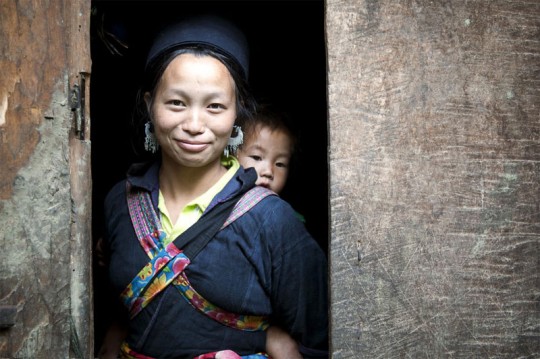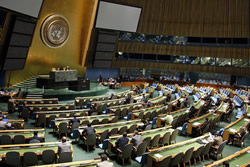Viet Nam: UN-backed study shows well-being disparities for children, women
Viet Nam: UN-backed study shows well-being disparities for children, women

Disparities in the well-being of children and women persist in Viet Nam, according to the findings of a United Nations-backed survey released today, which also shows that the differences vary across regions by gender, area of residence, wealth, and ethnicity.
On immunization, the finding of the multiple indicator cluster survey – carried out by Viet Nam’s General Statistics Office in partnership with government ministries, the UN Children’s Fund (UNICEF) and the UN Population Fund (UNFPA) – shows just two in five children between the ages of 12 and 23 months are fully immunized.
There is also a considerable gap between rural and urban areas, with one in two urban children fully immunised, compared to only one in three in rural areas.
On water and sanitation, the study shows that seven in 10 Vietnamese have access to drinking water and improved sanitation facilities. However, a person living in an ethnic Kinh or Hoa household is more than twice as likely to have access to those amenities as a person living in an ethnic minority household.
While the report shows that nearly one in every four children under the age of five in Viet Nam is stunted – shorter than he or she should be for his or her age – it found that the stunting rate among ethnic minority children is twice as high compared to their Kinh or Hoa peers.
Similar results were seen in the area of women’s reproductive health. Most women aged between 15 and 49 who gave birth in the two years preceding the survey received antenatal care at least once by skilled personnel, and two thirds had the recommended four antenatal care visits.
Nine out of 10 deliveries took place in health facilities, but significant disparities emerge by ethnicity. Virtually all women in Kinh or Hoa households delivered in a health facility compared to three out of five women from ethnic minority households.
“The report provides evidence that ethnic minorities are not faring well in most surveyed areas,” said Lotta Sylwander, UNICEF’s representative in Viet Nam. “The data generated… [in the survey] will allow policy-makers to target their resources to those population groups that are in most need of attention and should be the focus of collective development efforts.
“This would allow the benefits of Viet Nam’s economic growth to reach women and children in all ethnic, economic and social groups,” she said.
The report also shows that about a third of women who received antenatal care during their last pregnancy were tested for HIV. Significant disparities emerged by area of residence, with women living in urban areas twice as likely to have been tested compared to women living in rural areas.
The survey is an initiative which UNICEF has used since the mid-1990s to assist countries to collect and analyse data to monitor conditions for children and women.
###
Viet Nam survey shows disparities for children and women persist
Ha Noi, 16 December 2011 – Viet Nam’s Multiple Indicator Cluster Survey (MICS) 2010-2011 report, launched today in Ha Noi, reveals persisting disparities in the lives and well-being of children and women in Viet Nam, across regions, by gender, area of residence, wealth, and ethnicity.
The survey was carried out between 2010 and 2011 by the General Statistics Office (GSO) in close collaboration with various line ministries and UN agencies UNICEF and UNFPA. It provides a comprehensive, updated picture of the situation of children and women in Viet Nam.
“Work on the fourth round of the Viet Nam MICS started back in September 2010 and has seen the involvement of hundreds of committed individuals and numerous agencies, ensuring a robust and solid end product,” said Ms. Lotta Sylwander, UNICEF Viet Nam’s Representative. “I would particularly like to applaud the work of the “army” of interviewers who criss-crossed the country, braving the heat and humidity in the south or the cold rain and the snow in the north, traveling in sometimes extreme conditions, to collect invaluable data.”
MICS is an international household survey initiative which UNICEF has used since the mid-1990s to assist countries in collecting and analysing data in order to monitor the situation of children and women. MICS findings have been used extensively as a basis for policy decisions and programme interventions, and for the purpose of stimulating public discussion on the living conditions of children and women.
In the area of immunisation, the report shows that just two out of five children between 12 and 23 months are fully immunised in Viet Nam. There is also a considerable gap between rural and urban areas, with one in two urban children fully immunised, compared to only one in three in rural areas.
In the field of water and sanitation, the MICS 2010-2011 findings reveal that more than seven out of ten Vietnamese have access to drinking water and improved sanitation facilities. However, a person living in a Kinh or Hoa household is more than twice as likely to have access to those facilities as a person living in an ethnic minority household.
While the report shows that nearly one in every four children under five in Viet Nam is stunted–that is, shorter than he or she should be for his or her age—it found that the stunting rate among ethnic minority children is twice as high as that among their Kinh or Hoa peers.
Similar results were seen in the area of women’s reproductive health. Most women aged 15-49 who gave birth in the two years preceding the survey received antenatal care at least once by skilled personnel, and two-third had the recommended four antenatal care visits. Nine out of ten deliveries took place in health facilities. However, significant disparities emerge by ethnicity: virtually all women in Kinh or Hoa households delivered in a health facility compared to three out of five women from ethnic minority households.
“The report provides evidence that ethnic minorities are not faring well in most surveyed areas,” Sylwander said. “The data generated by MICS 2010-2011 will allow policymakers to target their resources to those population groups that are in most need of attention and should be the focus of collective development efforts. This would allow the benefits of Viet Nam’s economic growth to reach women and children in all ethnic, economic and social groups.”
Promoting the Prevention of Mother-to-Child Transmission of HIV is critical for reducing HIV prevalence. About one third of women who received antenatal care during their last pregnancy were tested for HIV. Significant disparities emerge by area of residence: women living in urban areas are twice as likely to have been tested compared to women living in rural areas (56 vs. 28 per cent). The percentage of those who were tested and told the results is much smaller (49 and 20 per cent).
This is the fourth round of MICS in Viet Nam, following those in 1996, 2000, and 2006. Results from the MICS will allow Viet Nam to better monitor progress toward national goals and global commitments, including the Millennium Development Goals, as the 2015 target year approaches.
“With more than 20 indicators belonging to the Millennium Development Goals collected and over 100 indicators relating to children and women incorporated, the Viet Nam MICS 2010-2011 provides important quantitative data that reflect achievements of the implementation of the National Programme of Action for Children 2001-2010 in Viet Nam, the MDGs, the Declaration and Action Plan for A World Fit for Children,” said Mr. Do Thuc, General Director of the GSO. “The report is also in time for the development of the National Programme of Action for Children 2011-2020,” he added.
“In-depth analysis of the MICS4 data will provide scientific evidence for the formulation of policies and programmes across a wide range of human development programs,” said UNFPA’s Viet Nam Representative Mr. Bruce Campbell. “This will work hand-in hand with data and analysis from other major sources of information such as the Population Census, the Annual Population Change Surveys and the Viet Nam Household Living Standards Surveys,” he added. “It is critical to utilise data from these sources to establish sound baselines against which development progress can be measured, and results demonstrated”
“Within the One-UN framework, UNICEF, UNFPA and other agencies are committed to continue supporting the Government of Viet Nam through our assistance to the General Statistics Office in the implementation of Viet Nam’s National Statistical Development Strategy 2011-2020,” Sylwander said. “Using the vital data from MICS will help us develop interventions to address poverty and inequities – not only to enhance the lives of children, but also to contribute to a culture of human rights and to improve social cohesion in Viet Nam’s society.”
###
About UNFPA
UNFPA, the United Nations Population Fund, is an international development agency that promotes the right of every woman, man and child to enjoy a life of health and equal opportunity. UNFPA supports countries in using population data for policies and programmes to reduce poverty and to ensure that every pregnancy is wanted, every birth is safe, every young person is free of HIV/AIDS, and every girl and woman is treated with dignity and respect.
###
About UNICEF
UNICEF works in 190 countries and territories to help children survive and thrive, from early childhood through adolescence. The world’s largest provider of vaccines for developing countries, UNICEF supports child health and nutrition, good water and sanitation, quality basic education for all boys and girls, and the protection of children from violence, exploitation, and AIDS. UNICEF is funded entirely by the voluntary contributions of individuals, businesses, foundations and governments. For more information about UNICEF and its work visit: www.unicef.org
###
> United Nations (UN).
 The United Nations was established on 24 October 1945 by 51 countries committed to preserving peace through international cooperation and collective security. Today, nearly every nation in the world belongs to the UN: membership totals 192 countries.
The United Nations was established on 24 October 1945 by 51 countries committed to preserving peace through international cooperation and collective security. Today, nearly every nation in the world belongs to the UN: membership totals 192 countries.
When States become Members of the United Nations, they agree to accept the obligations of the UN Charter, an international treaty that sets out basic principles of international relations. According to the Charter, the UN has four purposes:
- to maintain international peace and security;
- to develop friendly relations among nations;
- to cooperate in solving international problems and in promoting respect for human rights;
- and to be a centre for harmonizing the actions of nations.
###
* The above story is adapted from materials provided by United Nations (UN)
** More information at United Nations (UN)



















